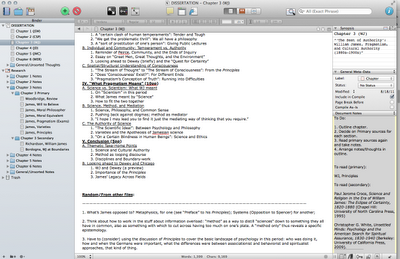Using Scrivener: A Brief Overview
After last week's post on the tools of the trade, I got a lot of feedback (mostly offline). I think Lukas is right that there's probably enough helpful material in our collective experience to justify a few more posts on methods.
Most feedback centered on Scrivener, the "content-generation tool" I've switched over to for my first chapter. Some readers had already been using it and chimed in with their favorite features, others picked it up for the first time and are now using it for dissertations.
The web is full of Scrivener reviews – a "Blogs" search on Google yields a dozen in the last couple days. Most reviewers that I've seen are (aspiring) novelists, concerned with character profiles and writer's block. As historians, we share those issues and have a few of our own.
What I thought I'd do in this post is just post a few screen-shots of my own set-up in Scrivener, and use those to suggest a few of the ways it's been most helpful to me as I organize my research notes into a single place and then start to outline and write chapter sections.
As I said last time, folks should adopt methods that suit their style of thinking and the material they've got to work with. Luckily, Scrivener's got a few different "looks" (and features) that match up with different ways of thinking. These are Document, Corkboard, and Outliner.
Here's Document View, Scrivener's main look for content-generation and note-retrieval:

Scrivener: "Document" View
What you're seeing here are the three main work panes. On the left is the "Binder," where notes and drafts are stored. In the center is the "Editor," where you write or read text files. On the right is the "Inspector," which displays meta-data about the document you're working on.
When I want to take notes on a new source, I open a new text file in the appropriate folder under "Research" in the binder (organized by chapter, split into primary and secondary sources) and start typing. Format and view options are arrayed at the top of the Editor.
I've created a blank file for each chapter up at the top, under "DISSERTATION," and that's where I've been outlining and dropping thoughts on my current work. Crucially, Scrivener lets you "split" the Editor to display a notes file and a chapter draft at once. That looks like this:

Scrivener: Splitting the "Editor"
This is (mostly) how I've been using Scrivener: after I've taken a bunch of notes on a source (or imported them from an archive trip), I scan through them with my chapter draft (well, chapter outline right now) open, copy-pasting relevant notes and quotes where I think they'll fit best.
This is just one way to view things, as I said. Another, and one some people might find really helpful, is the "Corkboard" view, which basically displays whatever portion of the binder you select as index card, allowing you to visualize (and shuffle) them in a new way. Check it out:

Scrivener: "Corkboard" View
Each of those little cards represents a (hypothetical) chapter, and the text displayed on them corresponds to a "Synopsis" in which you can summarize each of your documents. The Synopsis box, shaped like an index card, is in the upper-right corner of the first ("Document") image.One thing to keep in mind is that to take full advantage of the organizational potential of Scrivener, you've still got to be pretty scrupulous about maintaining your meta-data (so that you know which file you want to open when you see it in the Binder, for example...).
Another thing to keep in mind – and this might go without saying as well – is that things can quickly get out of control if you don't keep quotations tethered to data about their provenance, or clearly demarcate your own thoughts from those contained in the notes you've taken.
The Binder comes in two main sections to help with this: "Drafts," which I've renamed "DISSERTATION," and "Research," into which you can import PDFs and images (I'll write more about that function in a future post). But you've still got to keep track of things.
So, is Scrivener worth the $40? It has been for me. I recommend checking out the tutorials and FAQs on their website (they're really good), and snooping around the web for other takes on it. You get a free test-drive, so I'd say it's worth downloading and exploring yourself.
I hope this has at least given a more concrete sense of what Scrivener can do for a dissertator. It's best feature is that it enables you to keep your notes, your musings, and your drafts all in one place, which has already been helping me make connections for my new chapter.


